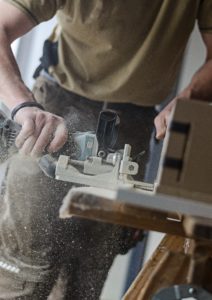Artificial “engineered stone” has grown in popularity in the last decade. It’s now one of the most commonly used materials for kitchen and bathroom countertops.
Engineered stone has replaced natural stone kitchen countertops like granite and marble. It’s a cheaper alternative that’s attractive, easy to clean, and less likely to crack or stain.
The problem? The workers who cut slabs of engineered stone are developing a fatal lung disease called silicosis. And it’s happening around the world.
How Dangerous Is Silica?
Silica dust particles, or crystalline silica, settle into your lungs, build up over time, and cause scarring that makes it hard to breathe. Silicosis is a result of inhaling silica dust in the air.
The dangers of silica (silica dioxide or quartz dust) have been known for years.
- Crystalline silica is “carcinogenic to humans” according to the International Agency for Research on Cancer (IARC).
- The U.S. Occupational Safety and Health Administration (OSHA) issued a “hazard alert” warning about silica in 2015.
Natural stone like marble contains about 10% silica. Granite is under 45% silica. But engineered stone is usually made up of over 90% silica.
Silica isn’t a danger once it’s installed in your home. The danger is when cutting slabs of stone to measure. Those most likely to be affected are:
- Construction workers
- Contractors or carpenters
- Countertop manufacturer employees
Concrete also contains silica, so concrete workers are also at high risk.
You can reduce your risk of silicosis to almost zero with the proper safety gear. Unfortunately, many companies don’t have the right safety systems in place to protect their workers.
You can develop silicosis if you’ve worked with it for years or even if you’ve worked with it a single time, depending on the amount of your exposure.
A March 2019 study in Australia reported that over 12% of countertop cutting workers got silicosis. In the United States, there are over 8,000 stone fabrication businesses and 100,000 workers who could be affected.
→ You could even be exposed if you weren’t working personally with the material, as long as the silica dust was in the air. Some cases of silicosis are housekeeping staff who swept and cleaned the dust after work had been done.
If you’ve worked with engineered stone and didn’t have the right safety gear, you should see a doctor right away – and then talk to a lawyer. You have rights and you shouldn’t have to bear this alone. Call Harlan Law at (619) 870-0802 to discuss your case today.
What Happens If You Breathe Silica Dust?
Some of those diagnosed with silicosis have had to get lung transplants. Others have died, including some workers who passed away in their 30s.
Silicosis and Silica Dust Exposure Symptoms
 Silica exposure can cause three types of silicosis:
Silica exposure can cause three types of silicosis:
- Acute – your symptoms come on a few weeks up to 2 years after exposure
- Chronic – most common; you may not have symptoms until decades after exposure
- Accelerated – your symptoms appear 5-10 years after exposure and worsen quickly
Silica exposure can also lead to lung cancer and kidney disease.
What Are the Symptoms of Silicosis?
Silicosis develops with the buildup of silica dust in your lungs.
Trouble breathing is a common early sign of silicosis, along with phlegm and a nagging cough.
Later symptoms of silicosis include:
- Greater trouble breathing
- Fatigue or weight loss
- Chest pain or shortness of breath
- Swollen legs or blue lips
- Sudden fever
If you have any of these symptoms, you should see a doctor right away.
Even if you don’t have symptoms, you should get checked for silica exposure. Especially if you’ve worked in dry stone cutting for any amount of time, even with protective gear.
How Do You Get a Silicosis Diagnosis?
Your doctor may do a chest X-ray or CT scan to check your lungs for scars. They may also do a bronchoscopy, where they run a long, thin tube with a camera into your lungs to look for damage. They may take a biopsy of your lung tissue to check it under a microscope.
Silicosis can lead to complications, including tuberculosis, chronic bronchitis, lung cancer, and other serious lung diseases like scleroderma and chronic obstructive pulmonary disease (COPD). Silicosis also puts you at a higher risk of getting the flu and pneumonia.
Is There a Cure for Silicosis?
Unfortunately, no. Treatment for silicosis focuses on managing your symptoms.
Silica Exposure Prevention
In 2016, OSHA issued tighter workplace limits on silica particles in the air. These new rules cut the permissible workplace exposure level of silica by half.
Your employer is responsible for providing a safe workplace for you. That could involve:
- Switching to wet stone processing to prevent silica dust
- Installing air filtration systems to reduce silica dust to an appropriate level
- Scrubbing the floor to dispose of any silica dust residue
- Using respirators when silica levels are high
- Educating employees about the dangers of silica dust
Your workplace conditions should not put your life or health in danger. Your employer must use reasonable care in providing a safe workplace for you.
Silicosis Lawsuit Cases
A silica lawsuit can be brought as a personal injury claim or a class action claim. You could also sue for products liability.
A silica class action claim would involve bringing together a group of people all affected by one defendant. For example, a group of workers suing a company. A personal injury claim would involve suing a defendant on behalf of you, personally.
The attorneys at Harlan Law have years of experience dealing with toxic tort cases like this. You have options. In cases like this, you can sue for silicosis on the basis that:
- Your employer was negligent and careless and failed to meet OSHA standards for silica exposure and prevention.
- The manufacturer of the engineered stone failed to properly warn you of the dangers of silica dust.
Toxic tort cases like this could end up with a large settlement, depending on the facts. You need a strong advocate on your side to get the compensation you deserve to make you whole again.
Call our office today at (619) 870-0802 to find out if you have a claim for silica exposure and silicosis – your first consultation is free.




